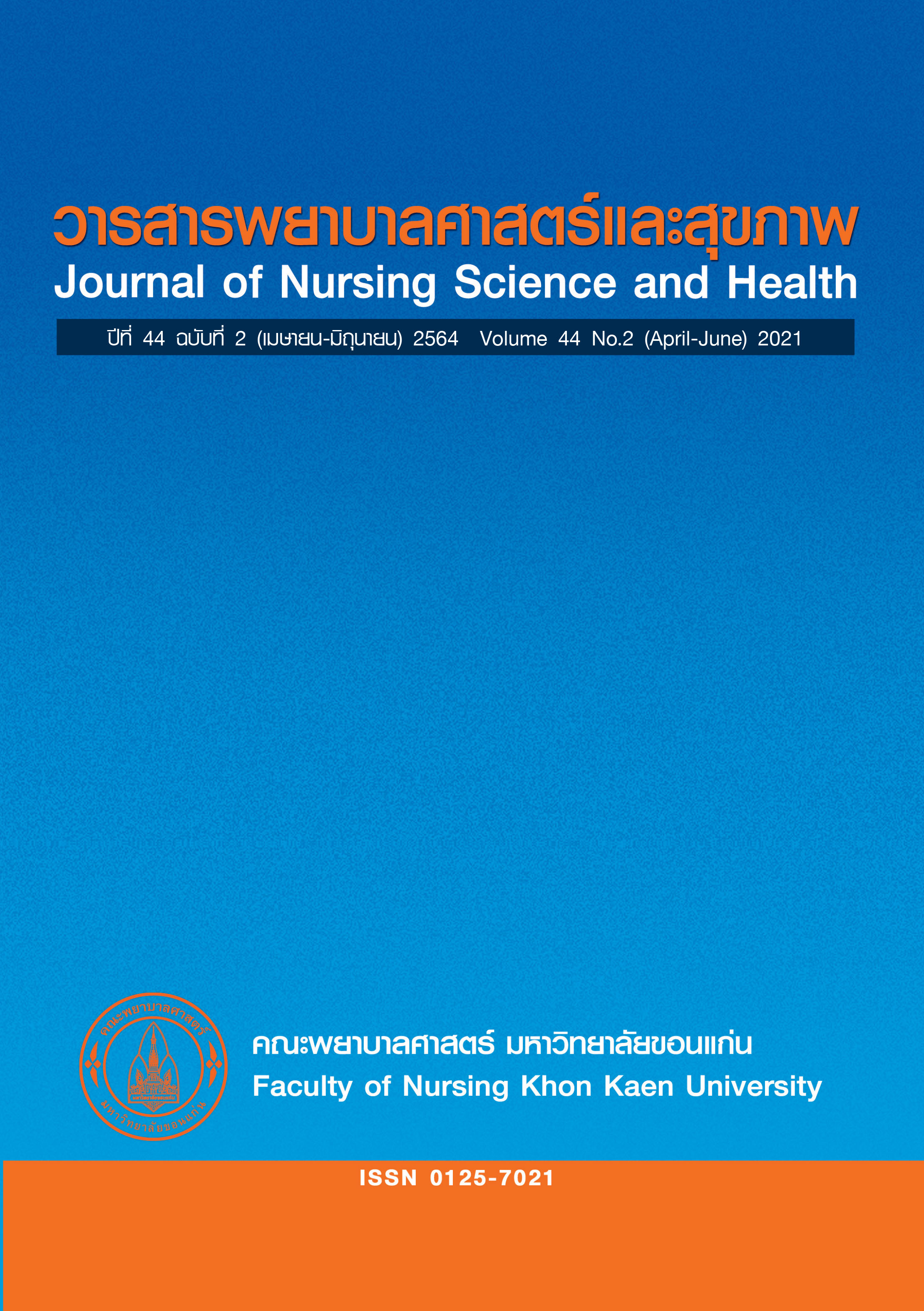การพัฒนารูปแบบการส่งเสริมการเลี้ยงลูกด้วยนมแม่สำหรับมารดาที่ทำงานนอกบ้าน
คำสำคัญ:
รูปแบบการส่งเสริมการเลี้ยงลูกด้วยนมแม่, มารดาที่ทำงานนอกบ้านบทคัดย่อ
การวิจัยเชิงปฏิบัติการเพื่อพัฒนารูปแบบการส่งเสริมการเลี้ยงลูกด้วยนมแม่ของมารดาที่ทำงานนอกบ้าน ผู้เข้าร่วมวิจัยประกอบด้วย มารดาที่ทำงานนอกบ้าน 30 คน บุคคลในครอบครัว 10 คน และเพื่อนร่วมงาน 5 คน โดยเลือกแบบเฉพาะเจาะจง รวบรวมข้อมูลโดยการสัมภาษณ์ การสนทนากลุ่มและแบบสอบถาม วิเคราะห์ข้อมูลเชิงเนื้อหาสำหรับข้อมูลเชิงคุณภาพ และวิเคราะห์ข้อมูลเชิงปริมาณโดยใช้สถิติบรรยาย ผลการศึกษาพบว่า มารดาที่ทำงานนอกบ้านมีความตั้งใจและเตรียมตัวเลี้ยงลูกด้วยนมแม่ให้ครบ 6 เดือน แต่มีอุปสรรค ได้แก่ ขาดข้อมูลที่ถูกต้องเกี่ยวกับการเลี้ยงลูกด้วยนมแม่ ความพยายามของมารดายังไม่เพียงพอ สมาชิกในครอบครัวไม่ให้ความร่วมมือ และหน่วยงานไม่เข้าใจความสำคัญของการเลี้ยงลูกด้วยนมแม่ นำไปสู่กระบวนการพัฒนารูปแบบการส่งเสริมการเลี้ยงลูกด้วยนมแม่ของมารดาที่ทำงานนอกบ้าน ประกอบด้วย 1) ให้การสนับสนุนข้อมูลข่าวสาร 2) ให้การสนับสนุนทรัพยากร 3) ให้การสนับสนุนด้านอารมณ์ และ 4) ให้การสนับสนุนด้านการประเมินค่า ผลการใช้รูปแบบนี้พบว่า มารดาที่ทำงานนอกบ้านทุกคนสามารถการเลี้ยงลูกด้วยนมแม่ได้ 6 เดือนขึ้นไป และยังพบว่าหลังใช้รูปแบบ คะแนนเฉลี่ยการสนับสนุนการเลี้ยงลูกด้วยนมแม่จากคนในครอบครัวอยู่ในระดับสูง (= 4.29, SD.= .11) และจากเพื่อนร่วมงานของมารดาที่ทำงานนอกบ้านอยู่ในระดับปานกลาง (
= 3.65, SD.= .19)
เอกสารอ้างอิง
United Nations Children’s Fund (UNICEF). From the first hour of life: making the case for improved infant and young child feeding everywhere. [Database on internet]; 2016 [cited 2020 Dec 7]. Available from: https://data.unicef.org/wpcontent/uploads /2016/10/From-the-first-hour-of-life.pdf.
American Academy of Pediatrics (AAP). Section on breastfeeding. Breastfeeding and the use of human milk–policy Statement. Pediatrics 2012;129(3):2827-41.
World Health Organization (WHO). Implementation guidance: protecting, promoting and supporting breastfeeding in facilities providing maternity and newborn services-the revised baby-friendly hospital initiative. [Database on internet];2018 [cited 2020 Dec 10]. Available from: http://www.who.int/nutrition/publications/infantfeeding/ bfhi-implementation-2018.pdf.
WHO and UNICEF. Global nutrition target 2025: breastfeeding policy. [Database on internet]; 2014 [cited 2020 Dec 10]. Avaliable from:http://apps.who.int/iris/bitstream /handle/10665/149022/WHO_NMH_NHD_ 14.7_eng.pdf?ua=1
UNICEF. Infant and young child feeding. [Database on internet]; 2019 [cited 2020 Dec 12]. Available from: https://data.unicef.org/topic/nutrition/infant-and-young-child-feeding/.
National Statistical Office of Thailand. Thailand multiple indicator cluster survey 2019, survey findings report. Bangkok, Thailand: National Statistical Office of Thailand; 2020.
Pichianwilai W, Chanthapreeda N. The effect of planned behavior program on exclusive breastfeeding behavior among working mothers. Journal of Nursing Science and Health 2014;37(1):12- 20. (in Thai)
Chunpia P. Working mothers and breastfeeding. In: Vichitsukon K, Sangperm P, editors, Continuing nursing education academic article about promotion of breastfeeding 14th ed., Bangkok: Siriyot Printing; 2014: p.103-9. (in Thai)
Prakongsai P, Cetthakrikul N. To the goal of breastfeeding, should Thai women be given additional maternity leave?. In: Thai Breastfeeding Center Foundation and scholars, editors, The 2nd series of breastfeeding literature review of Thai Breastfeeding Center Foundation: Breastfeeding is the best. Bangkok: Aiyarabook: 69-74. (in Thai)
Monsaeng I, et al. Summary report on the project of breastfeeding corner (full of warmth and love from mother's breast). Phayao: The Faculty of Nursing, Phayao University; 2012. (in Thai)
Chirawatkul S. Qualitative study in nursing. Bangkok: Witthayaphat; 2012.
Chaisuwan C. Predictive power of support from husbands, grandmothers and nurse on duration of exclusive breastfeeding. [Thesis]. Bangkok: Mahidol University; 2012. (in Thai)
Sunthorn Y, Suwimon P, Rathiya T, Umaporn K, Supawadee T, Yontrakul S, Development breastfeeding participatory integrated promotion model among community network of Maha Sarakham Hospital. Journal of Health Science 2013;22(6):988-96. (in Thai)
Tangsuksan P, Ratinthorn A. Experiences and contextual factors related to exclusive breastfeeding in full-time working mothers. Journal of Nursing Science 2011;29(3):52-63.
Phaiboonbunpot N, Anusornteerakul S. Effects of breastfeeding promotion program on knowledge, attitude, and breastfeeding skills among postpartum mothers. Journal of Nursing Science and Health 2015;38(1):41-52.
Meedya S, Fahy K, Kable A. Factors that positively influence breastfeeding duration to 6 months: A literature review. Woman Birth 2010;23(4):135-45.
Mekkamol K, Deejapo J, Netgrajang C. Effects of a model of 6-months exclusive breastfeeding promotion based on family-centered care on knowledge, attitude of mothers and families and exclusive breastfeeding for 6 months. Journal of Phrapokklao Nursing College 2016;24(2):47-59. (in Thai)
Yimyam S. Breastfeeding promotion among outside employed mothers. Nursing Journal 2013;40(3):129-37.
เผยแพร่แล้ว
รูปแบบการอ้างอิง
ฉบับ
ประเภทบทความ
สัญญาอนุญาต
วารสารพยาบาลศาสตร์และสุขภาพเป็นเจ้าของลิขสิทธิ์ในการเผยแพร่ผลงานที่ตีพิมพ์ห้ามผู้ใดนำบทความที่ได้รับการตีพิมพ์ในวารสารพยาบาลศาสตร์และสุขภาพไปเผยแพร่ในลักษณะต่าง ๆ ดังนี้ การนำบทความไปเผยแพร่ออนไลน์ การถ่ายเอกสารบทความเพื่อกิจกรรมที่ไม่ใช่การเรียนการสอน การส่งบทความไปตีพิมพ์เผยแพร่ที่อื่น ยกเว้นเสียแต่ได้รับอนุญาตจากวารสารพยาบาลศาสตร์และสุขภาพ



